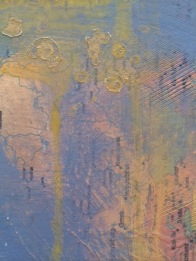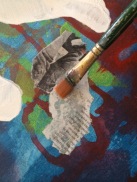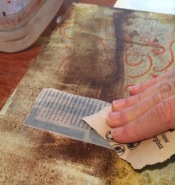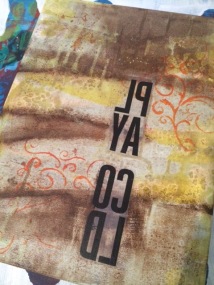
Raborn, “Notice,” 2014, acrylic and charcoal on panel, 25×25″
There are many reasons and ways to add language to our work. While teaching a mixed media workshop at the Arkansas Arts Center, I always wish we could spend more time on language, letters, and words.

Raborn, “The Code Breaker,” 2015, mixed media on panel, 18×24″
Words can be the focus of the artwork, the complete purpose of the piece. Or words can be subtly buried within the work. We can add thoughts, names, lyrics, accomplishments, names of places, religious passages, historic quotes, dates, poems, all sorts of words. Words can be used to set a mood, or can be used to contrast something in the piece. They can be unclear and confusing; they can be mysterious. They can be filled with meaning or completely meaningless. Letters can be used to establish a pattern, where the letter loses meaning and is simply a chosen shape for the composition, as seen in the work of Robert Rauschenberg. Words can be borrowed from the media or from a product to reference popular culture. There must be countless motives to incorporate words into artwork; I’ve listed just a fraction of the reasons.

detail of demo from Arkansas Arts Center workshop
If you are considering adding language to your work, here are a few methods. First, you can simply hand write on a painting. Try charcoal (use a spray fixative – even hair spray will work in a pinch), pencil, markers, paint….just about any mark making tool will work for handwriting on a water based paint such as acrylics or water color. You can also use all these mediums with letter and number stencils or stamps. Stencils and stamps produce a mechanical look with a hard edge which can be a stark contrast to loosely painted areas of a composition. Look at this Richard Prince piece (below) I had the joy of finding at the National Portrait Gallery in Washington, D.C. Notice the loose brushwork and monochromatic layers of paint. Notice the drips and the splotchy paint under the letters. The mechanical lettering highly contrasts the surrounding and underlying space which is a bit jarring for the viewer. Another contrast is set up conceptually: there is an odd humor among the dark palette. The disjointed messages are confusing and dark while simultaneously comical.

Richard Prince, “In Morning,” 2002, acrylic and oil on canvas, 89×75″

Detail from demo
Using collage by cutting letters out of old books, magazines or any printed material works well and is one of my favorite ways to add words, particularly when I plan to add more layers on top of the collaged letters. In the example on the left, I first glued color copies of a map on a gessoed canvas. After the glued paper was totally dry, I then added acrylic gel medium on top of the maps. While the medium was wet (and slightly thick), I raked a comb through the medium to create lined texture. After the medium dried, I painted over the entire piece with the light blue acrylic paint. In order to re-expose the map, I wiped back some blue paint with a damp paper towel (NOTE: in the last post of this workshop series, I will talk more about acrylic gel medium layers and about the yellow drippy layer).

Raborn, detail from “Mixed Messages,” 2015, mixed media on panel, 16×20″
Remember the recent post about image transfer? The transfer method is an excellent way to add language because the letters look embedded into the artwork instead of added on top.
While this sounds counter intuitive, I try not to think too literally when considering language in my work. I recall comments professor Taimur Cleary frequently made during grad school critiques. He pointed

Raborn, Untitled, 2014, acrylic and charcoal on panel, 32×24″
out that sometimes my marks resemble language. He allowed me to see the potential in creating marks that remind the viewer of letters and words but are meaningless (in terms of legibility). But the marks can still have a desired effect: making the viewer lean in and WANT to read the work. The IDEA of language as a form of communication can exist in a work without any actual letters or words! Following are two examples of the incorporation of words into paintings. They make it look so easy!

Robert Rauschenberg, “Dam,” 1959

Christopher Wool, The Harder You Look
If you’re still not feelin’ it and want to hear an inspiring lecture about the importance of words in every aspect of our lives, check out the TED Talk by writer Kelly Corrigan. It might initially seem unrelated to a mixed media workshop post, but opportunities like listening to Kelly’s talk is one of the many rudders that steers the direction of my artwork. I think you’ll find her inspiring, too.
http://tedxtalks.ted.com/video/More-Reading-Kelly-Corrigan-at

Next up: You think you can’t draw? Oh, yes you can! We’ll review several approaches to drawing and how to include the drawn line in your mixed media artwork. Thank you for reading! Laura
Hanging out with David Bailin, artist and drawing teacher extraordinare





 In another Hildebrand painting, the artist uses a drawing from his childhood and with painted line, tethers the drawing to the bulbous male form. Including the actual paper drawing in the composition conveys history. It doesn’t just allude to keepsakes – the dinosaur drawing on notebook paper IS a keepsake. The collage item encourages the viewer to ponder ideas about memory or childhood experiences traveling with us throughout adulthood.
In another Hildebrand painting, the artist uses a drawing from his childhood and with painted line, tethers the drawing to the bulbous male form. Including the actual paper drawing in the composition conveys history. It doesn’t just allude to keepsakes – the dinosaur drawing on notebook paper IS a keepsake. The collage item encourages the viewer to ponder ideas about memory or childhood experiences traveling with us throughout adulthood.





 ions. Until then, thank you for reading….and a Happy Healthy New Year to all!
ions. Until then, thank you for reading….and a Happy Healthy New Year to all! In the last post, I described a workshop I periodically teach at the Arkansas Arts Center. The focus of that article shifted from the purpose and joy of teaching to a specific technique from the workshop: the use of stencils and stamps. This second post of the series focuses on a technique we explore in class called Image Transfer. First I’ll describe HOW to do image transfer, then I’ll talk about WHY. As with most art materials, there are countless ways to use this technique and, of course, reasons abound.
In the last post, I described a workshop I periodically teach at the Arkansas Arts Center. The focus of that article shifted from the purpose and joy of teaching to a specific technique from the workshop: the use of stencils and stamps. This second post of the series focuses on a technique we explore in class called Image Transfer. First I’ll describe HOW to do image transfer, then I’ll talk about WHY. As with most art materials, there are countless ways to use this technique and, of course, reasons abound.




















